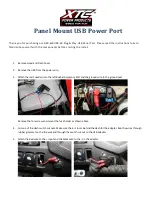
GS350_300_GS F_OM_OM30G34U_(U)
221
4-3. Operating the lights and wipers
4
Dr
iving
■
Camera sensor detection information
●
The high beam may not be automatically turned off in the following situations:
• When oncoming vehicles suddenly appear from a curve
• When the vehicle is cut in front of by another vehicle
• When vehicles ahead are hidden from sight due to repeated curves, road dividers or
roadside trees
• When vehicles ahead appear from the faraway lane on wide road
• When vehicles ahead have no lights
●
The high beam may be turned off if a vehicle ahead that is using fog lights without using
the headlights is detected.
●
House lights, street lights, traffic signals, and illuminated billboards or signs may cause
the high beam to switch to the low beams, or the low beams to remain on.
●
The following factors may affect the amount of time taken to turn the high beam on or
off:
• The brightness of headlights, fog lights, and tail lights of vehicles ahead
• The movement and direction of vehicles ahead
• When vehicle ahead only has operational lights on one side
• When vehicle ahead is a two-wheeled vehicle
• The condition of the road (gradient, curve, condition of the road surface etc.)
• The number of passengers and amount of luggage
●
The high beam may be turned on or off when the driver does not expect it.
●
Bicycles or similar objects may not be detected.
●
In the situations shown below, the system may not be able to accurately detect sur-
rounding brightness levels. This may cause the low beams to remain on or the high
beams to cause problems for pedestrians, vehicles ahead or other parties. In these
cases, manually switch between the high and low beams.
• In bad weather (rain, snow, fog, sandstorms etc.)
• The windshield is obscured by fog, mist, ice, dirt etc.
• The windshield is cracked or damaged.
• The camera sensor is deformed or dirty.
• The camera sensor temperature is extremely high.
• Surrounding brightness levels are equal to those of headlights, tail lights or fog lights.
• Vehicles ahead have headlights that are either switched off, dirty, are changing color,
or are not aimed properly.
• When driving through an area of intermittently changing brightness and darkness.
• When frequently and repeatedly driving ascending/descending roads, or roads with
rough, bumpy or uneven surfaces (such as stone-paved roads, gravel tracks etc.).
• When frequently and repeatedly taking curves or driving on a winding road.
• There is a highly reflective object ahead of the vehicle, such as a sign or a mirror.
• The back of a vehicle ahead is highly reflective, such as a container on a truck.
• The vehicle’s headlights are damaged or dirty, or are not aimed properly.
• The vehicle is listing or tilting, due to a flat tire, a trailer being towed etc.
• The high beam and low beam are repeatedly being switched between in an abnor-
mal manner.
• The driver believes that the high beam may be causing problems or distress to other
drivers or pedestrians nearby.
Summary of Contents for GS F
Page 7: ...7 1 8 7 6 5 4 3 2 GS350_300_GS F_OM_OM30G34U_ U 9 ...
Page 16: ...16 Pictorial index GS350_300_GS F_OM_OM30G34U_ U Exterior rear GS350 GS300 GS F ...
Page 20: ...20 Pictorial index GS350_300_GS F_OM_OM30G34U_ U Switches GS350 GS300 GS F ...
Page 22: ...22 Pictorial index GS350_300_GS F_OM_OM30G34U_ U GS350 GS300 GS F ...
Page 24: ...24 Pictorial index GS350_300_GS F_OM_OM30G34U_ U GS350 GS300 GS F ...
Page 26: ...26 Pictorial index GS350_300_GS F_OM_OM30G34U_ U GS350 GS300 GS F ...
Page 28: ...28 Pictorial index GS350_300_GS F_OM_OM30G34U_ U Interior GS350 GS300 GS F ...
Page 131: ...GS350_300_GS F_OM_OM30G34U_ U 131 2 Instrument cluster 2 Instrument cluster ...
Page 132: ...132 GS350_300_GS F_OM_OM30G34U_ U 2 Instrument cluster ...
Page 424: ...422 GS350_300_GS F_OM_OM30G34U_ U 6 3 Do it yourself maintenance ...
















































